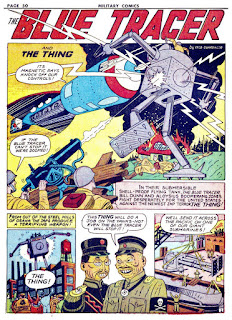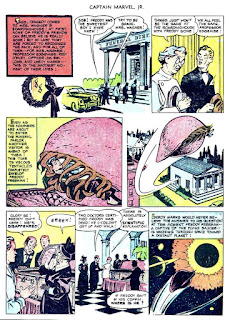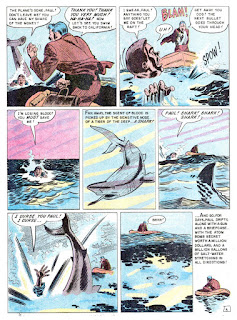My idea years ago was to present this blog as a fanzine, numbering the posts like I would number a print publication. I thought to give Pappy’s readers something special whenever I reached the milestone of another 100 “issues” of Pappy’s. I also thought of it as a way of keeping me interested. (I found myself becoming inconsistent in this practice after a while.)
However, when I was consistent, Number 1000 was posted in 2011, and the subject was the rare DC ashcan, Double Action Comics #2.
I have always been interested in the subject of ashcans, a sample magazine slapped together in order to secure the copyright for the title with the Library of Congress, then tossed away (hence “ashcan.”). I wonder if today all of that stuff is done digitally, instead of print?
Click on the thumbnail for scans of the complete ashcan.
Translate
Friday, May 31, 2019
Wednesday, May 29, 2019
Number 2344: The Blue Tracer and The Thing
The Blue Tracer, created, written and drawn by comic book veteran and journeyman, Fred Guardineer, was a feature in Quality’s Military Comics. Guardineer had been in comic books since they began, and before that did illustrations for pulp magazines. During his career he did a wide variety of comic book characters, all done with his precision style of drawing. Guardineer’s work is easy to spot...just look for the lines that appear to be drawn by a machine.
Fred Guardineer quit comic books in about 1954, then went to work for the United States Post Office. They offered a pension. As a former freelancer for his years in comic books, the idea of a pension seemed good to him. As it was he lived a long time, and probably enjoyed that pension. Born in 1913, he died in 2002, just short of his 89th birthday.
There are some racial insults hurled at the Japanese in this story. It is representative of feelings toward America’s enemies in World War II. But the story also has a giant robot called The Thing, and giant robots I cannot pass up. It appeared in Military Comics #12 (1942).
Fred Guardineer quit comic books in about 1954, then went to work for the United States Post Office. They offered a pension. As a former freelancer for his years in comic books, the idea of a pension seemed good to him. As it was he lived a long time, and probably enjoyed that pension. Born in 1913, he died in 2002, just short of his 89th birthday.
There are some racial insults hurled at the Japanese in this story. It is representative of feelings toward America’s enemies in World War II. But the story also has a giant robot called The Thing, and giant robots I cannot pass up. It appeared in Military Comics #12 (1942).
Monday, May 27, 2019
Number 2343: Wallace Wood in the Stone Age
I believe that Wallace Wood drew better when he got a story he was interested in drawing. This story, “The Lost Kingdom of Athala” is one of those. It has a prehistoric setting, it has a beautiful girl in an abbreviated animal skin. And it even has a Wood-version of a Tyrannosaurus Rex. I read it, but I more-or-less dismissed the story to look at the artwork.
However, during a second look I did read it, and note, this is a spoiler: sexy Rhoa, the cavewoman ruler, says she wants to be like other girls of leading man Jack Rance’s world. I doubt she’ll be thinking that when she gets to that era in the time machine Jack and his young friend traveled in. She just doesn’t fit into that early '50s era, when women were expected to be in the kitchen or taking care of the kids. And speaking of time machines, that odd-looking mechanical device looks clunky to me, not as sleek as the devices we are used to seeing Wood draw.
The story was printed originally in Strange Worlds #4, an Avon comic from 1951. My scans came from a 1958 IW reprint, Strange Planets #9.
However, during a second look I did read it, and note, this is a spoiler: sexy Rhoa, the cavewoman ruler, says she wants to be like other girls of leading man Jack Rance’s world. I doubt she’ll be thinking that when she gets to that era in the time machine Jack and his young friend traveled in. She just doesn’t fit into that early '50s era, when women were expected to be in the kitchen or taking care of the kids. And speaking of time machines, that odd-looking mechanical device looks clunky to me, not as sleek as the devices we are used to seeing Wood draw.
The story was printed originally in Strange Worlds #4, an Avon comic from 1951. My scans came from a 1958 IW reprint, Strange Planets #9.
Friday, May 24, 2019
Number 2342: Face-to-face with Micro-Face
Micro-Face was an unusual hero with a gimmick: Among other tricks, he could turn his voice into a megaphone. Public Domain Super Heroes has this to say about Micro-Face: “Tom Wood was a factory worker and a failed inventor. Years ago, he invented a “Micro-Mask“ — a full-face mask that contained a built-in microphone (which allowed hm to amplify and throw his voice), a hearing amplifier, and “photoelectric lenses” that gave him x-ray vision. He could also attach telephone wires to his mask to make phone calls. Tom offered the invention to the U.S. government, only to be turned down.
When his brother, Jim Wood, was shot by gunfire of gangsters, Tom promised to avenge his death.To that end, he decided to use his invention and an old masquerade costume to costumed crime-fighter known as Micro-Face.”
Hmmm. “Photoelectric lenses that gave him x-ray vision”? “Attach telephone wires to his mask to make phone calls”? Those U.S. government guys were saps to turn those inventions down!
Micro-Face appeared in 10 of the 15 issues of Clue Comics from Hillman publishing. The character was created and drawn by Allen Ulmer. Ulmer worked in comic books for several years, but there are also photos of some of his fine art online. According to Rogallery.com Ulmer was born in 1922 and died in 1990.
The story is from Clue Comics #2 (1943):
When his brother, Jim Wood, was shot by gunfire of gangsters, Tom promised to avenge his death.To that end, he decided to use his invention and an old masquerade costume to costumed crime-fighter known as Micro-Face.”
Hmmm. “Photoelectric lenses that gave him x-ray vision”? “Attach telephone wires to his mask to make phone calls”? Those U.S. government guys were saps to turn those inventions down!
Micro-Face appeared in 10 of the 15 issues of Clue Comics from Hillman publishing. The character was created and drawn by Allen Ulmer. Ulmer worked in comic books for several years, but there are also photos of some of his fine art online. According to Rogallery.com Ulmer was born in 1922 and died in 1990.
The story is from Clue Comics #2 (1943):
Wednesday, May 22, 2019
Number 2341: Boy Beetle, Herbie
This is a story about Herbie Popnecker, and how he found pop music stardom. He stuck a mop on his head, turned his name around to Eibreh Rekcenpop, then warbled a couple of songs to drive the girls wild! As pop stars of that era will tell you, it was not easy to compete with the Beatles. It was more of a long and winding road to stardom for most. But Herbie, errrr, I mean Eibreh, has some sort of irresistible charm about him. Herbie is so charming that he charmed a whole bunch of people into buying his comic book in the sixties, and even now it is seen as something still charming, even unique in comic book history.
In “Herbie, Boy ‘Beetle’” the Beatles really aren’t prominent; they appear in a few panels and then vanish, leaving the rest of the story to Eibreh and jealousy from established artists Dean Martin and Frank Sinatra. Just when you think the story couldn’t get any screwier, Dean and Frank assault Herbie by cracking objects over his head. That physical stuff never works on Herbie, who is impervious to harm..
Written for Herbie #5 (1964) by ACG editor Richard E. Hughes under the name Shane O’Shay, and drawn by the master of deadpan humor, Ogden Whitney. Herbie is, as always, a very unusual hero. And we love him, yeah yeah yeah.
In “Herbie, Boy ‘Beetle’” the Beatles really aren’t prominent; they appear in a few panels and then vanish, leaving the rest of the story to Eibreh and jealousy from established artists Dean Martin and Frank Sinatra. Just when you think the story couldn’t get any screwier, Dean and Frank assault Herbie by cracking objects over his head. That physical stuff never works on Herbie, who is impervious to harm..
Written for Herbie #5 (1964) by ACG editor Richard E. Hughes under the name Shane O’Shay, and drawn by the master of deadpan humor, Ogden Whitney. Herbie is, as always, a very unusual hero. And we love him, yeah yeah yeah.
Monday, May 20, 2019
Number 2340: The eyes have it
My jaw dropped to my desktop when I saw the cover of Captain Marvel Jr #115 (1952). Good thing I have a beard to cushion the impact. As we have seen before, Fawcett used horror for some of the Marvel Family titles, seeing as how horror comics were the big sellers in that period. The illustration by Bud Thompson is a good example of what Dr Fredric Wertham, M.D. in his 1954 book, Seduction of the Innocent, called the injury to the eye motif. In this era of graphic horror movies this cover does not seem as shocking today as it probably was to readers in 1952. What I can say about it now, decades later, is it is one that Dr Wertham missed.
Graphic eyeball violence notwithstanding, I like the story. “The Thousand Eyed Idol of Doom,” is credited to artist Bud Thompson, and script by William Woolfolk, according to the Grand Comics Database. Oh yeah, and flying eyeballs are the flying saucers!
The most famous of the “injury to the eye” examples, found in SOTI, and the story it came from. Just click on the thumbnail.
Friday, May 17, 2019
Number 2339: Harvey Kurtzman and the atom bomb thief
“Atom Bomb Thief!” was written and drawn by Harvey Kurtzman for Weird Fantasy #14 (actual issue #2, 1950).*
At the time there was a lot of talk about atomic secrets being stolen, and the Russians building their own bomb (the Soviet Union detonated their first nuclear bomb on August 29, 1949, so it was in the news.) Besides the pay-off of the story being obvious, EC Comics used those snappy surprise endings so often the ending was not a real surprising surprise, but at least appropriate to the build up.
SPOILER ALERT: Kurtzman used a real life nuclear test as his ending, the Baker bomb test at Bikini Atoll in July, 1946. Camera footage from that test was used at the end of Stanley Kubrick’s dark 1964 fantasy, Dr Strangelove or How I Learned to Stop Worrying and Love the Bomb.END SPOILER
Kurtzman’s story was also a way for him to use some cinematic effects in his drawings, enhancing the storytelling. I especially like the the layouts of the first and last pages.
*Weird Fantasy had been “formerly A Moon...A Girl...Romance” in order to save on having to buy a new second class postal permit. In this case they got caught after five issues, so they had to start re-numbering with issue number 6. The result was issue numbers repeated later on, affecting issue numbers 13 through 17.
Subscribe to:
Posts (Atom)























































